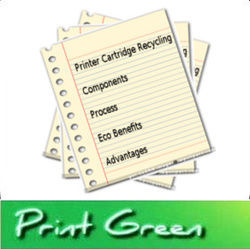 To learn more about the topic, talk about it. That's why instead of asking everyone to do their part and be one with the environmentally responsible citizen around the world, I'll be providing must known facts about printer cartridges recycling. Printer consumables such as the ink and toner cartridges, even the drum unit, for a business that requires printing on a daily basis these supplies may generate a totally huge cost. Not all that, once these items reached their end of life or usage limit, there are two paths from which they could probably end up, it's either on the recycling plants or landfills. Although there are programs and agencies that promote proper e-waste disposal, still a certain percentage of such waste materials Cartridges components consist of plastic, metal, rubber, paper and foam. About 80% of it composed plastic and metal, the remaining percentage are the other components. There are two types of printer cartridges, one is the ink cartridge and the other is the toner cartridge, say if you include it on the overall components that made up a cartridge, nearly 97% of a cartridge's components can be recycled.The recycling process that a printer cartridge go through is not similar to the ones you commonly know. In general, it involves cleaning, refurbishing, segregating, drilling, and refilling, something more like that. Even the recycling process that each manufacturer used must be certified by the print industry standards in order to prevent substandard products from disseminating in the market.Economically speaking, recycled toner cartridges and ink cartridges only cost 50% less than branded supplies. The significant cost reduction doesn't mean these printer consumables are of bad quality. Remember that they're made of recycled components from original cartridges, hence the manufacturer doesn't use raw materials in the production process. Cartridge recycling also require less energy consumption which makes recycled products more affordable.Years ago, millions or even billions of printer cartridges are being dumped in the landfills and incinerators. After they developed the right method of cartridge recycling, eventually the number of printer supplies that undergo recycling increased over time. Thus, more consumers are gradually accepting the market for recycled toner cartridges and ink cartridges from which aside from the fact that they save money through using it, they also aid on sustainability.
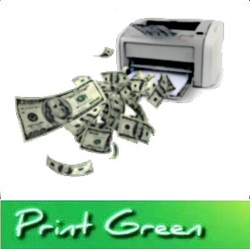 It's practical to think before you do anything else. Unless you don't belong to that type of person, guess it would be better to consider changing some irregular habits. Same with printing practices, in order to cut down expenses a strategy can be considered a good plan to break some old records. To minimize printing expenses due to high priced consumables such as ink cartridges and toner cartridges, plus the electricity a machine consumes during its operation, there are easy ways to consider. Printer consumables are resources that you can't avoid to buy for your machine, so instead of eliminating them which is actually not possible, find a way to shrink the need to frequently buy a new one. Less consumption means less demand, right? Before you get to print anything, think if it's really important for you to have a hard copy of it. If yes, recheck the file for any errors or anything that might cause you to reprint it. Doing so will prevent wasting ink/toner consumables, paper materials and electricity. Send it through email and not as a printed copy. As much as you can attached a file or image in an email, do so, instead of printing it then carrying or sending it to the receiver. If you can practice this, you can eliminate hassles and more of it, and noticed that you don't have to use your printer just to let someone have its own copy. Same thing applies on you, carrying bulky files and documents like office papers and reports, that's old school, try saving your files in a storage device then just view it using a PC, laptop or projector anytime you need. If it's really required to have a hard copy then go have it printed, but make sure you wouldn't end up having piles of draft copies and test pages. Again think before you print. Ask yourself, are all these pages need to be printed, does it need to be in full color copy or just plain black, should you include the page numbers and footers or probably not? Those are just my examples, you can have a lot of questions to ask yourself before hitting the print button. Well of course there are instances that a file composes of several pages, and you have no choice but to print all of it, then a good suggestion is to consider using compatible cartridges. These replacement cartridges are not substandard, major printer manufacturers recycle their own products, so what's the reason you shouldn't opt for it? Using remanufactured toner cartridges and ink cartridges, or often called recycled printer consumables, won't harm your printer. Take note that using an original cartridge from a branded manufacturer may result to print errors just as using compatibles.
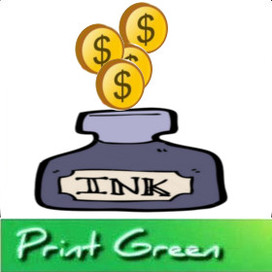 To many, switching to green printing practices means saving money, but to some people who are environmentally concern, it isn't just saving but helping the environment as well. Businesses and consumers are both getting benefits in the process, and it's very useful in the user's end for they get what they need with the same value for almost half the price. Green printing practices may start even at the the time you will buy a printer. It's not only the way you print that matters, more importantly you should also pay attention to the machine that you're using. Is it rated with Energy Star, or certified for energy efficiency? U.S. Environmental Protection Agency or EPA provides guidelines and metrics that aren't that high to consider for a printer not to pass. To make it more simple, while choosing a printer just ask the tech guy in charge of assisting you, ask about the energy usage and efficiency of a particular model you want.Most high-end printer models in the market nowadays are typically with features and functionality that are not just energy or cost efficient, but are eco-friendly as well. Some good features include : Duplex (double-sided) printing, which is needless to explain why it's an effective feature, Eco-mode and Sleep-mode are also excellent. Additionally, using high-capacity printer cartridges may reduce cost-per-page with every print. Xerox ink blocks for ColorQube printers are unique and ideal to consider. If you really want to save more while aiding in the sustainability and environment protection. Switch to using eco-friendly toner cartridges and ink cartridges for your printer. These printer consumables are commonly available in the market in bargain prices. The big names in print industry also recycle their supplies and products, so how can you say recycled printer cartridges are substandard? It's not always on the brand or model or price that quality can be measured, it's on the way you print.
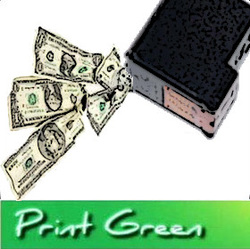 It's quite unusual to see an office or any working environment not to have any printing machine, or even a stand-alone copier, fax and scanner. Actually even an individual who works at home requires such devices. Honestly these devices are the fruits of technology which became widely popular due to the fact that most offices and professionals needs a printing machine. However, these printers require consumables such as toner and ink cartridges which harm the environment. Of course we can't just eliminate printers and other electronic devices just in order to get rid of their consumables. What will happen if we forbid people to use such machines, how can they be more productive and what can they use to replace it? So to solve the problem with printer consumables, recycling has been applied by several manufacturing companies into their products. Hence, these companies prevent the cartridges from filling up the landfills or worse contaminate the surrounding areas where people dump their wastes.Regardless of how complicated the process there is to recycle a single piece of empty cartridge, its effect is enormously worth it. Considering that the manufacturers don't need to use virgin materials and resources to reproduce products, the amount of energy and natural resources that the process can save may reach up to 80%. If you try to draw it as pie chart, looking at the bigger fraction, it seems like your playing pacman and the 80% space gets to eat the remaining 20%. Kidding aside, sooner or later researchers will find a way or rather a solution to max out the advantage of recycling.Although a few consumers are more concern of saving their hard-earned money rather than the environment, in the process of cartridge recycling manufacturers, consumers and the environment as well are all getting benefits. You know for a fact that cartridge recycling also has a certain limit, and those components which can no longer be recycled are still reuse. If you're not yer participating to any recycling programs or organizations, here's a good thing to consider. Wise consumers doesn't only use recycled toner cartridges and ink cartridges to save money, they also sell them to recycling plants that accept return cartridges for a price. Sounds great isn't it, you get to earn a few bucks while making yourself environmentally responsible.
 Ricoh USA, one of the well-known manufacturers of copier, printer, fax machines scanners and similar machines related to the Print Industry, is not only known for its electronic products but also for its commitment to the environment. Their acts and efforts aren't widely known yet, and it doesn't matter so long as what their doing is noble and aids in sustainability. Ricoh as not everyone knows, is quite impressive to spend roughly $3000 a month for their recycling project which includes collecting used or empty printer toner and ink cartridges. These information are mainly from their recycling facility in Malaysia alone, since I haven't gotten much details about the company's other recycling areas. Additionally, Ricoh also collects unused or worn-out printer equipments, copiers and other electronic devices to ensure that these products are disposed properly and that they wouldn't end up in the landfills. The company's reliable technical supporters are the ones responsible for collecting the printers, copier, etc., from customers who want to dispose it. Instead of just letting those products become land-fillers, they're taking them to Ricoh's recycling plant. Through recycling electronic products, Ricoh was able to manufacture brand new printers and copiers from used components and materials.In addition, RIcoh USA also facilitates several return programs for printer toner cartridges, container and maintenance kit. The company pushes it all by encouraging most of its customers to recycle their printer supplies by participating in any of their return programs. Out of these used supplies, they managed to produce recycled toner cartridges and ink cartridges which reflects the company's environmental responsibility. Mr. Peter Wee, COO of Ricoh Malaysia, mentioned that their company will be focusing on SME (Small and Medium Enterprises). Probably in the mid quarter of this year, there's an expected launching of new laser printers from Ricoh which aims to boost the company's venture in the field of small and medium enterprises.
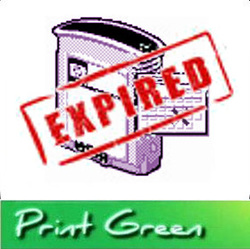 Printer cartridges just like any other consumables in the market also have their own expiry date. Although there are no actual proofs about the harmful effects or disadvantages of using expired printer cartridges, let's just put it this way, an expired food may caused food poison, period. Even if it still looks good to use, it's best not to try it in your printer, unless you'll take all the risk that may result from using it. A printer cartridge's expiration date is visible from its label or packaging so you don't have to worry how you'll know when will it expire. If they will still work or not, I can't give much details as even I haven't tried using an expired ink or toner cartridges. But do you know that even a good as new cartridge may become useless just like an expired one, even if it hasn't reach its expiry? Printers which are not frequently use tend to have clogged ink cartridges or toner build up. If the cartridge inside the machine is left unused tendency is it might end up useless over a period of time. The ink thickens inside the cartridge then eventually turn compact due to chemical changes. Hence a new cartridge should also become as worthless as an expired cartridge if not use regularly. To ensure you won't experienced such problem, better use the cartridges all the way until it deteriorates instead of letting it dried for nothing. On the manufacturer's part, expired printer cartridges means loss in profit. Low consumer demand will result to cartridges supply being stocked on shelves and storage rooms of retailers. It was a nice thing to know that printer cartridges can be recycled, and many manufacturers especially the big names in the print industry recycle their supplies. One thing is for sure, manufacturers, consumers and the environment are all benefiting from recycling printer consumables. Most customers prefer it over OEM since they're much affordable and produce less carbon footprints. These eco-friendly toner cartridges are one of the solutions that may help on reducing ecological effects of technology to the environment. The next time you go shopping for replacement cartridges, check the label and packaging and see the expiration dates. Prefer the ones with longer expiry date so you can still make use of it once the current cartridges in your printer runs out of ink.
Being a geek doesn't mean you can't do more things to save the environment aside from loving the fruits of technology. Actually you are more responsible of doing such task to protect the environment where you live. How can we say so? Since you're patronizing IT industry products like gadgets, equipments, machines, and devices, those high-tech materials can potentially harm our planet. Hence, you should be mindful of its possible effects and how can you be of help on reducing such negative impacts of using and disposing tech materials. Handheld devices like smartphones and tablets are undeniably irresistible, I confess that I do have each of those but certainly I know how to properly handle and make use of them without harming the environment. Do you know that Apple also has their own Recycling Program? For iOS gadget lovers, which includes me although I'm not a fan, you can send in or drop off those unused or damage devices for recycling purposes. If I may recall, I've read a post about Apple making a cheaper version of the iPhone5 using recycled components from returned handsets. Sounds too good to be true, but believe my it'll soon happen. Don't be addicted to gaming consoles, just enjoy it but make sure of setting limits and barriers to yourself. Too much is not always good. Self-control is the key to avoid addiction to such products. Indeed it is nice to spend some time just playing without worrying about the real world. But once in a while it wouldn't be that much if you consider turning it off and be one with the nature. Plus, reducing your time from gaming products and similar devices will lead to much lower electricity bills right. If you're a camera and photo enthusiast, or say you're in to photography, aside from having digital cameras like DSLR and the likes, you might also have a photo printer to get those captured images printed. Cameras don't produce that much harmful effects to the environment, ironically they capture heart pounding scenery of beautiful places that who knows when will it fade its beauty. While the printer you use may lead to negative ecological effects, especially if its consumables are not disposed of properly. Drafts and initial printouts more likely generate tons of wasted paper materials and inks, not to mention the money you spent to purchase those supplies. One of my recommended solution is to use recycled toner cartridges and ink cartridges for your printer. They're made from refurbished components of original cartridges, thus conserving resources, also these alternatives are half way cheaper compared to branded supplies. Try to monitor yourself, are you one of those who are doing those things above, or are you one of those who are just reading it and later on will forget about it? It always depends on your decision, should you go for a greener life style or stick from where you've been used to doing, that's your choice.
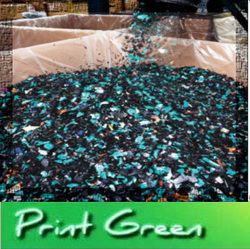 It's kind of easy to assume the process of ink cartridges recycling, someone can say it's just grinding and melting then voila you have a new ink container. But everything in the process of recycling takes more than just those two things. Quality control and a lot of complicated steps must be delivered in order to cope with the daily demand for replacement printer consumables. From original cartridges, after they run out of inks, users may either send them back or deliver it directly to many recycling facilities. Then, returned cartridges undergo sorting and cleaning, by removing any harmful metals and non-plastic materials from each container. We're talking about recyling plastic-made materials, thus any other components aside from plastic must be separated. Afterwards, here goes the famous grinding process where it harshly chopped and cut all those cartridges into tiny little pieces. After grinding and shredding, extra ingredients were added into the mixture such as shredded PET bottles and the likes, to make them more sturdy and pliable just like a new cartridge made from virgin materials. The mixture is then toss into an enormous V-shaped blending machine to grind the materials again and let all the components blend well. The raw mixture will be extruded from the machine, which then be used for manufacturing new replacement cartridges. Indeed, it's more likely easy to refill a small container with inks or toners, but considering the ecological impacts of doing such thing, I'd gladly reject the option. Choosing eco-friendly toner cartridges and ink cartridges for all printing needs is still way better than any other options available. Instead of manufacturing new printer cartridges using virgin materials from our natural resources, why not invest on establishing more recycling plants. Quality control plays a key-role in the recycling process. It may seem too complicated right now but economically and environmentally speaking, printer cartridges recycling has a lot of good points.
The video above explains the process on how HP recycles all returned and used printer cartridges. Everything was explained by none other than Mr. Dean Miller, Hewlett-Packard's programme lead for printer cartridges recycling. HP made it successful to developed a close loop recycling program which gives second life to all plastic materials by turning them into printer cartridges. Before, it used to be more of like shredding each pieces of used toner and ink cartridges into tiny little pieces. Such process can shred thousands of plastic wastes in just an hour, however it creates a contaminated mixture of several materials which come from the cartridges. Upon discovering it, HP developed a better way of recycling printer consumables, and that is by dismantling those materials instead of crushing them. Result-wise HP achieved what they want, and that is to have a contaminant-free and much cleaner recycling process. Basically the process includes : scrapping off the label, cutting the lid, removing electronic components as well as the pads, then lastly a robot arm tosses the ink/toner tank into a receptacle. Chemical additives are also involve in the recycling process to make each recycled cartridges as sturdy and good as new. So to those who are still doubtful whether to use or not to use recycled toner cartridges and ink cartridges, there we have the video, and there you have a very well known company stating facts about recycling. If there's such company that promotes and acknowledges cartridge recycling as a better option to improve ecological impacts, what hinders you from not participating on such great act? Recycle your printer cartridges, used, empty, or worn-out, whatever it is, send them out to your respective manufacturer, they should know what to do with those. There are several options and ways that you can choose from on how to return cartridges back to them, instead of letting those printer waste end up in the landfill. Let those plastic wastes have their new life as a useful printer cartridge.
When was the last time you upcycled some worn out or used materials? Giving those reusable stuffs a second life isn't a sweaty task, in fact its a fun way of recycling your waste materials instead of throwing them away and probably end up in the landfills. While browsing the net, I was surprised to see a lot of clever crafts and creations that were made from used consumables particularly those empty printer ink cartridges. Here are some of the best upcycling ideas that I've found: Epson ink cartridges turn into a lighting fixture.Lowell and Louise, the artists behind the colorful and fancy small chandelier. They make use of various ink cartridges, arranged it into a circular shape like a lamp cover, then hang it using an aluminum bar screwed on a chain. Since the cartridges were already empty, once the bulb at the center lights on it creates a luminous effect. Actually the couple didn't remove the brand stickers which makes the light a little bit dim. However the color of each ink cartridges creates a subtle variation, so therefore I agree on not removing the stickers. Discarded printer cartridges turn into a bike path.Way back 2010, Australian National Park Service created a bike path made entirely of worn out ink cartridges. It reaches 10.6 mile that stretches along the northwest territory of Australia between Alice Springs and Simpsons Gap. Although it cost them about $330,000 to finish it up, the remarkable experience of every bikers that crosses and appreciates it is priceless. Empty HP ink cartridges turn into a USB drive.Actually it was just a do-it-yourself craft that anyone can do with their USBs and printer cartridges. If you're interested on doing it, check out this link Printer Cartridge USB Drive. It's plain and simple, just make a hole on the opposite side of the cartridge where the chip is embedded, punch it or hammer it, your choice. Make sure the hole is large enough so you can insert the USB drive. Try to make the hole in a rectangular shape, then put the USB drive inside the cartridge and let the metal part (the one you plug into the port) out. Glue it and make it secure so you can hold the cartridge like it's the main USB itself. Who said that upcycling is a hefty task? Imagine thousands of printer cartridges are just being dumped in the landfills, and just a small fraction of them are being recycled. Aside from those recycling organizations and facilities that accept returned printer consumables, indeed they help on reusing plastic materials by providing recycled toner cartridges and ink cartridges. But still there's a huge number of discarded ink and toner cartridges that end up in incinerators and mostly in the landfills.
|







 RSS Feed
RSS Feed